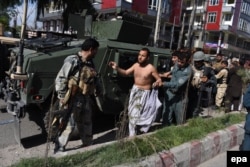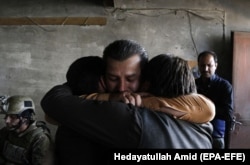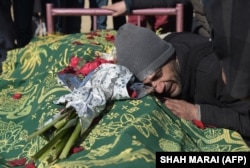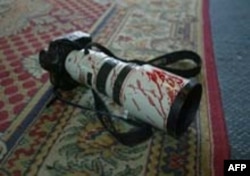A homophobic gang assaults a gay technical-school student in Fargona, Uzbekistan, a country where sexual activity between men is a crime -- stripping the victim naked, beating him with a stick, and forcing him to insert a beer bottle into his anus, then posting video of the attack on the Internet.
Several men force an Uzbek woman to confess that she has worked as a prostitute while they film her for a “shame video” distributed on social-media networks.
Angry shopkeepers at a clothing market in Urganch accuse a teenage girl of theft and take the law into their own hands -- stripping her naked from the waist up, beating and kicking her, and forcing her onto the street while a man who encourages the attack shoots a video that goes viral in Russia and other former Soviet republics.
All are examples of so-called vigilante videos posted recently to the Internet from Uzbekistan -- incidents in which self-appointed posses of citizens armed with smartphones, and sometimes weapons, attacked and humiliated suspects rather than report them to law enforcement for the authorities to judge.
It’s impossible to independently confirm whether mob attacks against suspected wrongdoers are on the rise in Uzbekistan, or even whether authorities are doing anything to address the problem.
The government in Tashkent does not keep statistics on vigilante attacks and won’t comment on the issue.
But with several recent Uzbek "vigilante" videos going viral in other countries, authorities say they are concerned about the impact the footage is having on Uzbekistan’s reputation.
As a result, they’ve launched a campaign to discourage such people from posting videos of their attacks on the Internet -- instructing neighborhood crime-watch activists “not to take the garbage out of the house for the outside world to see.”
The initiative is being conducted by regional officials, who rarely carry out public-awareness campaigns in Uzbekistan without instructions from senior government officials in the capital.
Public meetings have been called at schools to bring together teachers, local residents, and members of neighborhood committees known as mahalla residential-community associations.
One such meeting was held on November 4 at School Number 36 in Urganch, a regional capital in western Uzbekistan, after vigilante video from the city's clothing market was broadcast by Russia’s REN-TV channel and went viral.
Sayora Abdukarimova, chairwoman of the regional Committee for Women’s Issues, told teachers and mahalla activists at the meeting they must do everything they can to prevent videos of “internal issues” from circulating on the Internet.
Abdukarimova also instructed those at the meeting to spread the word about the importance of preventing Uzbek vigilante videos from been seen outside of Uzbekistan.
The images come at a particularly sensitive time for Uzbekistan, which has spent most of the past three decades of independence lumbering under accusations of egregious rights violations and authoritarian excess. Tashkent has been on an outreach offensive since President Shavkat Mirziyoev succeeded Islam Karimov after the entrenched strongman died last year, pursuing a thaw with its neighbors, pledging to eliminate cumbersome "exit visas" for its citizens, and touting plans to resurrect inward-bound tourism.
The video from the Urganch clothing market shows more than a half dozen shopkeepers stripping the blouse and bra off of a 17-year-old girl and beating her after she allegedly tried to steal clothing.
The assault and alleged theft were never officially reported to police, although RFE/RL Uzbek Service interviews with shop owners at the market and a police officer who patrols the neighborhood confirm that the attack took place on October 7.
The police officer familiar with the attack, asking not to be identified, says thefts take place on a regular basis at the market and that “all sides involved” usually “take care of this themselves without referring cases to law enforcement officials.”
That's why investigations usually are not launched into such theft cases and statistics on vigilante attacks are not kept, the officer tells RFE/RL.
But Nigora Rajabova, a member of the Xorazm region’s Committee for Women’s Issues, insists the Urganch market video is a fake.
“The incident shown by REN-TV never took place,” Rajabova tells RFE/RL. “This video was created by our enemies. There was no vigilante attack at the clothing market nor at the agricultural market in Urganch. In general, these kinds of incidents never happen in the Xorazm region. Laws are respected in the region and all laws are implemented here. I repeat again, the video shown by REN-TV and spread by social media never took place in the Xorazm region. This is a provocation by our enemies.”
Gavharjon Solaeva, a travel agent who relies on income from tourists who visit the Xorazm region’s UNESCO World Heritage Site in Khiva, says authorities are concerned foreign travelers may avoid the region “after seeing this video” because they also would fear “vigilante attacks.”
“Our president recently visited Xorazm and made it clear that tourism must be developed here,” Solaeva says. “The president met with our newly appointed regional governor, Ilgizar Sobirov, and ordered him to develop tourism.”
Mahalla 'Crime Watch'
Experts say a group psychology for vigilante attacks in Uzbekistan stems from the long-time reliance of police on mahalla activists in local crime-prevention programs.
Uzbekistan’s mahalla committees are state-sanctioned neighborhood organizations that were reshaped from Soviet-era informant networks -- networks where residents would report suspicious behavior by neighbors to police and intelligence officials.
Tashkent psychologist Mahmudjon Yuldoshov tells RFE/RL that vigilantism “is one of the issues in a society where laws do not work mainly because of the society’s past.”
Murdo Ismailov, an Uzbek mahalla expert at the University of Tsukuba in Japan, notes that the most regularly conducted activity of mahalla activists -- nearly two-thirds of all volunteer work -- is within neighborhood “crime-prevention” and “night-watch” programs.
“One explanation is that Uzbekistan has seen dozens of terrorist attacks and radical religious intrusions in recent history,” leading government and police “to actively engage local citizens in crime prevention by organizing regular meetings and exercises,” Ismailov says.
“Whatever form such interactions take, it is clear that the majority of [mahalla associations] in Uzbekistan actively encourage residents to participate in vigilante group activities,” Islamilov adds.
Tashkent-based criminal attorney Ruhiddin Komilov says the apparent prevalence of vigilante attacks in Uzbekistan “proves that there is no trust in the legal system.”
“Since laws do not work, people decide that they are judges, investigators, and prosecutors themselves,” Komilov says. “As long as criminals are not punished [under the legal system] and there are doubts about the principle of inevitable punishment, then certainly, these kinds of situations will continue -- if not increase.”
Still, authorities in Tashkent have shown that they are prepared to detain and prosecute vigilantes who are reported in the most notorious cases -- like the horrific abuse of the gay student in Fargona that was recorded and posted online by his attackers on September 29.
Following reports by RFE/RL’s Uzbek Service about that vigilante video, Uzbekistan’s Interior Ministry announced on October 5 that it had arrested five men for the attack and confiscated their mobile phones as evidence.
Those suspects now await trial on charges of making violent death threats, attempting to drive a person to commit suicide, premeditated infliction of bodily harm, robbery, and hooliganism.







